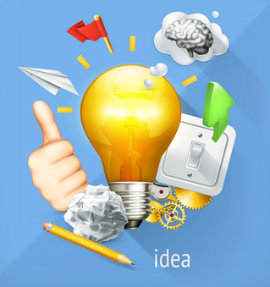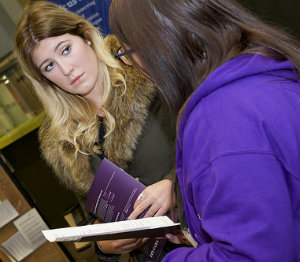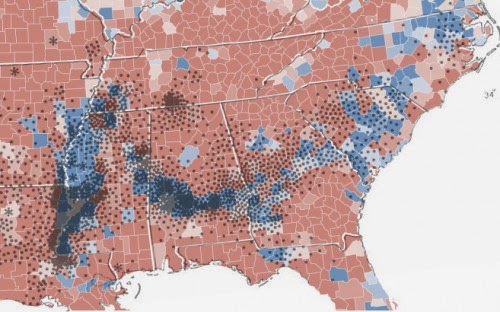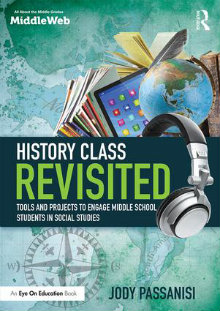Design Thinking in the History Classroom
A MiddleWeb Blog
I usually have a clear idea of what I am going to do in my first unit. I have my set historiography activities that I expect (well, hope) will blow the students’ minds when they realize that history is an interpretative narrative and not necessarily a string of facts.
This year, however, is different. This year I’ve decided to embark on a Design Thinking challenge for every regular unit that I teach. That means that my units on the Constitution, the Revolutionary War, the Federalists and Democratic Republicans, Westward Expansion, Causes of the Civil War, Civil War, and Reconstruction (and, if I’m lucky, the Progressive Era) will all be looked at through the lens of Design Thinking.
It’s the wild west of teaching, and I am both excited and nervous to embark on the journey.
The elements of Design Thinking

This method is being used now in some classrooms to encourage students to problem solve, to look at inquiries in new ways, and to invent and create solutions to challenges. This is an emerging educational strategy, with many methodological similarities to Project Based Learning.
I strongly recommend the resources put forth by IDEO if you want to delve more deeply into the strategy. The process that I will follow with my students will be broken into the following steps:
- Empathize
- Define and Research
- Ideate
- Experiment, Reflect, Revise
- Share
While Design Thinking and its best friend, Project Based Learning, are found in many a science classroom, it seems to me that history classrooms are a bit more reticent to take up the mantle of, especially, Design Thinking pedagogy. Why?
Why Design Thinking belongs in history class
Any teacher reluctance may have to do with the fact that Design Thinking is a truly relevant and engaging pedagogy that is meant for students to solve problems that exist now. And, obviously, in history class we are dealing with the stuff of the past. Also, history is a subject where content often is king. It’s hard to cede control of the content and relinquish the goal that students might hit every content mark that’s expected.
So applying Design Thinking in history courses could be seen as challenging, but I see it as a great opportunity. For my U.S. history students, what could be more relevant than looking for solutions to challenges that were created in the past and are still having impact on our lives today?

Then, my students will choose one problem that spoke to them or possibly relates to their own life. That’s their design challenge: to create a solution to the problem that they heard about.
Will they get to every bit of content about the Constitution that I would have hoped? Possibly not, but on the other hand, the students are going to find themselves hard pressed to be able to solve a problem in government without a great deal of context to support their ideas. They will have to delve into federal, state, and local issues, I expect.
Discovering solutions, whether past or present
Later, the students will identify a problem in the Civil War or Reconstruction. You don’t have to be a history teacher to draw a through line from those 19th century events to current civil rights issues (as this map demonstrates). So the students will look at history, go back in time, choose a problem in Reconstruction and solve it – either in the past to affect the present OR in the present by implementing something that would fix a problem Reconstruction had created.

Southern Black Soil ~ Slavery ~ King Cotton ~ 2008 Poverty, in One Map
Design Thinking in history requires the same tools as in other disciplines: strong and rigorous research, free and creative brainstorming with wild ideas, convergence with analysis of desirability, feasibility, and viability, and reiteration and reflection.
The stakes can be high for these students engaged in Design Thinking in history – they really could get in there and help to think of new solutions for problems we face. They will just be looking at history to guide them.
Bringing together writing, soft skills and content
I see the history classroom with Design Thinking as a three pronged approach. Students still need to write — I will have my students stop periodically to do workshops on expository reading, research skills, and writing (all based on what they are need for their projects) and then do an on-demand writing after the unit/project.
Additionally, there has been much talk of the “soft skills” that students will need to get along in this new world that awaits them: collaboration, perseverance, creativity, etc. Design Thinking activates these skills and more: it creates self-efficacy, risk-taking – all of the things we say we want to see in our students.
And, finally, a promise to those who love history and the details of history: students will learn content. It may be not precisely what one might expect that content to be: it may be deeper, it may be better, and it may surprise us what they learn and understand as a result of looking at the content in this new way. And it may reinvigorate teachers, too.
Have you used Design Thinking in your history class? How has it gone?
Reference: Tom Kelley & David Kelley, Creative Confidence (2013).
Image credit: Map from Strange Maps contributor Mark Root-Willey, used in The Black Belt: How soil types determined the 2008 election in the deep South, November 17, 2008, The Vigorous North.







































Check out this 9th grade lesson using Tinker decision about freedom of speech in schools issue as a parallel to students wanting to wear Confederate flag t-shirts. Draws on empathy and opportunity to jump off this discussion to research other freedom of speech/expression issues locally or nationally. Free resource – requires log in but there’s no cost.
Great! Thanks for sharing!
I loved being a social studies teacher – we had a “cognitive apprenticeship” approach to learning about american history called “YOU be the Historian” sorting through primary source information to determine the “truth” – what you are sharing is sooo important for students to think their way through not only history [as told my WHO] and present reporting of history but “futuring” as well. Thank you for this sharing – PLEASE keep giving us a peek into the journey. Oh yes – eighth grade was my turf – wouldn’t have had it any other way.
Those interested in this approach – might consider the resources of “Facing History and Ourselves” – i really like the research, dialogue, perspectives and drawing conclusions to issues that concern us today as well as past.
In my history class, we use the design process to start the year, using an empathy map to consider the problems that bother us in not-so-great classes, and help us to get ideas about the really great class we envision. We read some John Locke—building in some text-annotation, note-taking, and write-arounds—then ideate and create the social contract that we will use to keep life, liberty, and property intact so that we can focus on engaging activities and projects, then tweak as the year goes on as our needs change. I’ve really been pleased with what the students come up with, and am definitely looking for other ways to incorporate design thinking into the rest of the year’s work. Thanks for this article.
That seems to be quite interresting. But I just cant figure out exactly how it works. I understand for the actual stuff with the gvt. But how do you achieve that with.. let’s say the civil war? can you give me a complete exemple of it?
For now, it seems really interresting but I need to understand it better before I try it (which I really wanna do)
Thanks
Martin
Thanks for reading and commenting, Martin! I just made a checklist today to walk the students through the smaller steps of the process to provide more structure to the open-endedness of the project- feel free to email 21centuryteachr@gmail.com and I can send you the prototype. For the Civil War – off the top of my head- I might go with the “what-if” strategy: e.g: come up with a compromise or other diplomatic means that you could argue would solve the underlying problems, come up with a strategy for the South that could have won the war…
Does anyone have any suggestions for upper elementary social studies? We cover American history from the European colonization through the Civil War. I am trying to implement Design Thinking philosophy in a 5th grade classroom. Any thoughts are appreciated.
Hi Sally – did you ever hear from the author? I too teach 5th grade Humanities and we finish the year with the Civil War. While we do a lot of PBL, I really like the idea of DT and would like to implement it.
If you heard anything – l’d really appreciate it if you would email me with what was said. Thanks.
Gretchen
gfogelstrom@saccds.org
Didn’t hear back from anyone re: my specific grade level question…sometimes DT and American history are hard to synch.
We are planning a DT project in 5th grade related to Conservation.
Hi Gretchen- and Sally- I did something with my eighth graders last year around Civil War technology- had them create a technological innovation that would solve a problem that people had during the war. The great thing about design thinking prompts is how they can be adjusted so easily for older or younger students with some tweaks. Gretchen- I will email you the materials I used last year.
Jody, could you email me the materials (and any other suggestions) you used for the Civil War unit? I’m still interested in downsizing for my 5th graders. Thank you.
Hi Sally Jo,
please send me an email and I will send you what I have! 21centuryteachr@gmail.com
Thank you, Jody
I guess I kind of did that…. I teach AP World History and I like to use games…. SO I used Minecraft as a way to teach ancient civilizations and Civilization V to do alternate methods of history and Continuity and Change over Time. My students had an assload (sorry) of work to do with the Civ 5 project, including:
What is historiography and how does it inform how we study history? Pick and define one historiographical school, then apply it to the real life scenario and your simulation.
Did your scenario illustrate or portray a Western view of history? What is meant by that statement, and how could the game portray different cultural viewpoints?
Do some research about the real scenario you simulated. You are to find at least five sources and cite them in Turabian or Chicago bibliographic citation style (at the end of your presentation or visual aide):
2 Primary Sources 1 Scholarly Monograph
2 Scholary Journal Articles
Based on your research, I would like you to engage in some hypothetical historical speculation. How would the world TODAY be different if the loser of the real historical scenario had been the victors. How would the world be the same?